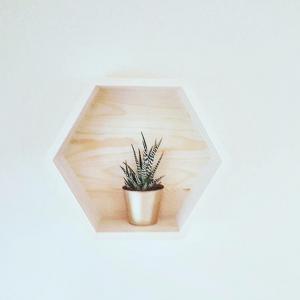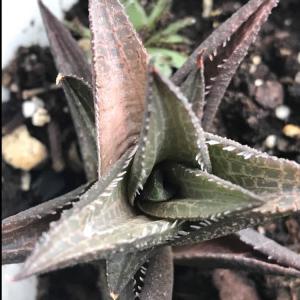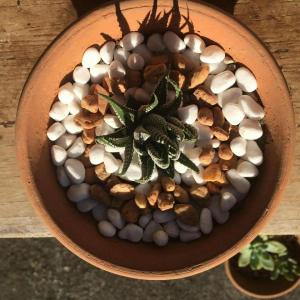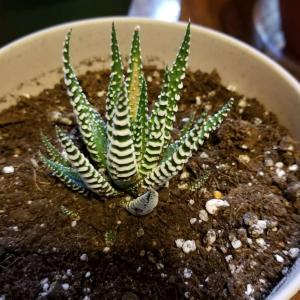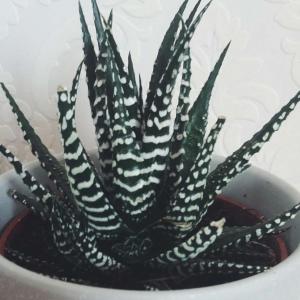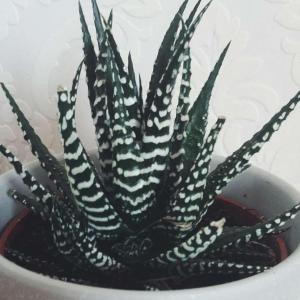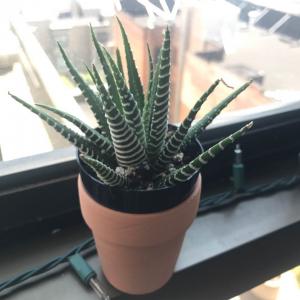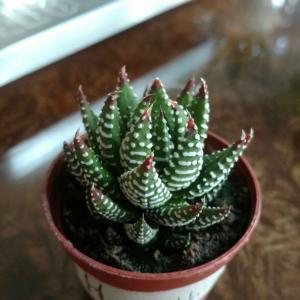成长记
Kiersten_27
2017年10月17日

I now added "Zebra haworthia" in my "garden"


5
0
萌萌的南瓜:It looks so cute ✨🌸
文章
Dummer. ゛☀
2017年10月02日

Scientific Name
Haworthia attenuata (Haw.) Haw.

Common Names
Zebra Plant, Zebra Haworthia
Synonyms
Haworthia attenuata var. attenuata, Apicra attenuata, Aloe clariperla
Scientific Classification
Family: Xanthorrhoeaceae
Subfamily: Asphodeloideae
Genus: Haworthia

Flower
Color: White and green
Bloom Time: Can be ever blooming if you snip off each bloom when it dies.
Description
Haworthia attenuata is a stemless clustering perennial succulent, up to 6 inches (15 cm) tall. The rosettes are 3 – 6 inches (7 – 15 cm) in diameter, with 30 – 40 dark green leaves, 3 inches (8 cm) long with white tubercles. The Inflorescence is 16 inches (40 cm) tall, white flower with green veins.
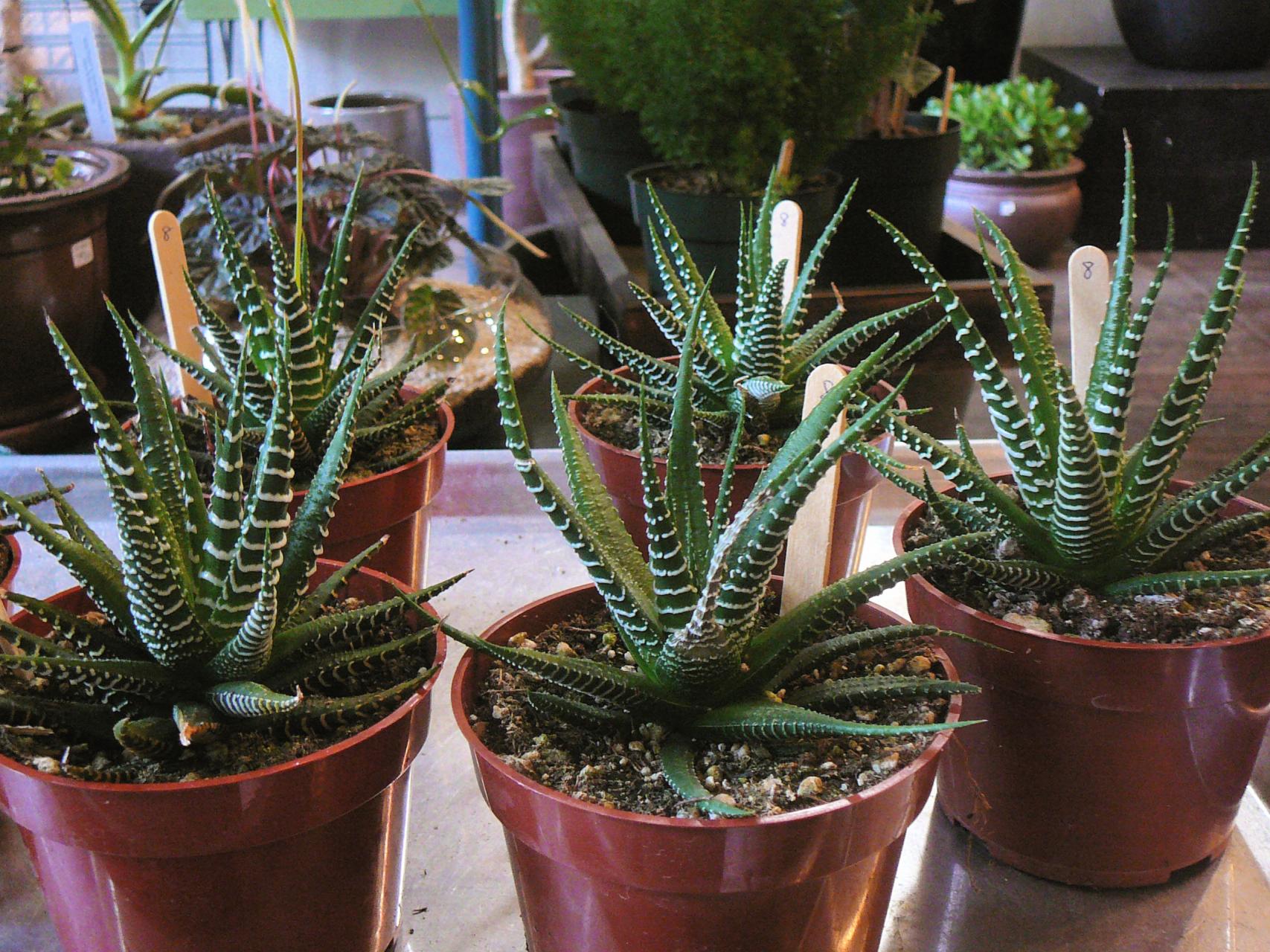
How to Grow and Care
Display Zebra Plant anywhere it can receive plenty of sun or bright light. South facing windows will provide the most sun, however, east or west provide direct sun part of the day that I find more suitable.
During the growing season from April to September water the Zebra Plant thoroughly and then water when the soil becomes dry to the touch (not bone dry though). Winter is a tricky time for these plants although they are a tough species. Many growers will overwater then alongside cold temperatures or drafts the plant can become very sick, or even die. The leaves are storage organs so during the winter water much less and allow the top soil to dry out.
Use a cactus potting mix that drains wells and provides plenty of air to the small roots. If making you own mix or buying another type, use part potting soil, part perlite and part sand.
Origin
Native to South Africa (Eastern Cape).
Haworthia attenuata (Haw.) Haw.

Common Names
Zebra Plant, Zebra Haworthia
Synonyms
Haworthia attenuata var. attenuata, Apicra attenuata, Aloe clariperla
Scientific Classification
Family: Xanthorrhoeaceae
Subfamily: Asphodeloideae
Genus: Haworthia

Flower
Color: White and green
Bloom Time: Can be ever blooming if you snip off each bloom when it dies.
Description
Haworthia attenuata is a stemless clustering perennial succulent, up to 6 inches (15 cm) tall. The rosettes are 3 – 6 inches (7 – 15 cm) in diameter, with 30 – 40 dark green leaves, 3 inches (8 cm) long with white tubercles. The Inflorescence is 16 inches (40 cm) tall, white flower with green veins.

How to Grow and Care
Display Zebra Plant anywhere it can receive plenty of sun or bright light. South facing windows will provide the most sun, however, east or west provide direct sun part of the day that I find more suitable.
During the growing season from April to September water the Zebra Plant thoroughly and then water when the soil becomes dry to the touch (not bone dry though). Winter is a tricky time for these plants although they are a tough species. Many growers will overwater then alongside cold temperatures or drafts the plant can become very sick, or even die. The leaves are storage organs so during the winter water much less and allow the top soil to dry out.
Use a cactus potting mix that drains wells and provides plenty of air to the small roots. If making you own mix or buying another type, use part potting soil, part perlite and part sand.
Origin
Native to South Africa (Eastern Cape).
6
6
文章
Dummer. ゛☀
2017年09月23日

Commonly called Zebra Plant, Haworthia attenuata is a cold-sensitive succulent species grown for its eye-catching, green and white textured leaves. It is hardy within U.S. Department of Agriculture hardiness zones 10 and above and will produce an abundance of offshoots, or pups, once established in a sunny bed. The offshoots provide a simple and highly effective means of propagating new Zebra Plants if they are carefully removed and potted in a suitable growing mix. However, they should only be removed in spring or autumn when the plant is not actively growing, to reduce stress to both the offshoots and the parent plant.
Locate the rooted offsets around the base of the zebra plant. Carefully scrape away the soil from around the base of the offshoots and look for small, pale pink or white roots.
Insert the blade of a gardening knife into the soil midway between the parent plant and the rooted offshoot. Slide the blade through the soil to sever the connecting root.
Etch out a 2-inch radius in the soil around the base of the rooted offshoot using the tip of your gardening knife. Dig down along the radial line to a 5-inch depth using a small handheld spade.
Insert the blade of the handheld spade at an angle underneath the rooted offshoot. Carefully pry it loose from the soil and remove it. Fill in the hole left by the offshoot to protect the parent plant’s roots.
Crumble off half the soil from around the offshoot’s rootball. Pot it in a small, 3- to 4-inch nursery container. Use a potting mix made up of 2 parts perlite, 2 parts coarse sand and 1 part sterile compost.
Place the potted zebra plant offshoot where it will receive bright, diffuse light and temperatures above 68 degrees Fahrenheit, such as in a glasshouse, cold frame or indoors near a south-facing window.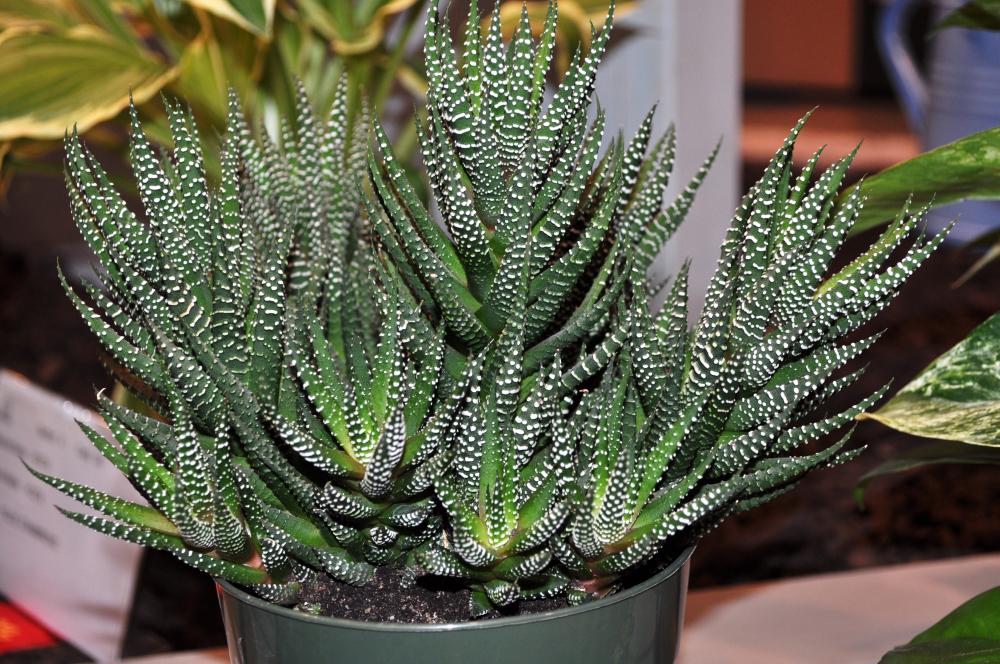
Withhold watering for the first three days. Water only until the soil feels barely moist in the top inch. Maintain light, even moisture in the soil mixture, but allow it to dry out for a day or so once a week.
Remove Offsets From a Zebra Plant
Things You Will Need
Garden knife
Handheld spade
3- or 4-inch nursery container
Perlite
Coarse sand
Sterile compost
Tip
Unrooted Zebra Plant offsets can be rooted in pure perlite or coarse sand before planting, but they are subject to a high rate of die-off.

Locate the rooted offsets around the base of the zebra plant. Carefully scrape away the soil from around the base of the offshoots and look for small, pale pink or white roots.
Insert the blade of a gardening knife into the soil midway between the parent plant and the rooted offshoot. Slide the blade through the soil to sever the connecting root.

Etch out a 2-inch radius in the soil around the base of the rooted offshoot using the tip of your gardening knife. Dig down along the radial line to a 5-inch depth using a small handheld spade.
Insert the blade of the handheld spade at an angle underneath the rooted offshoot. Carefully pry it loose from the soil and remove it. Fill in the hole left by the offshoot to protect the parent plant’s roots.

Crumble off half the soil from around the offshoot’s rootball. Pot it in a small, 3- to 4-inch nursery container. Use a potting mix made up of 2 parts perlite, 2 parts coarse sand and 1 part sterile compost.
Place the potted zebra plant offshoot where it will receive bright, diffuse light and temperatures above 68 degrees Fahrenheit, such as in a glasshouse, cold frame or indoors near a south-facing window.

Withhold watering for the first three days. Water only until the soil feels barely moist in the top inch. Maintain light, even moisture in the soil mixture, but allow it to dry out for a day or so once a week.
Remove Offsets From a Zebra Plant
Things You Will Need
Garden knife
Handheld spade
3- or 4-inch nursery container
Perlite
Coarse sand
Sterile compost

Tip
Unrooted Zebra Plant offsets can be rooted in pure perlite or coarse sand before planting, but they are subject to a high rate of die-off.
0
0
文章
Dummer. ゛☀
2017年09月19日

Native to South Africa, these clump forming succulent plants have similarities with the Aloe plants and they’re related with the same subfamily. There are also subspecies grown.
In their natural habitat (subtropical) Zebra Plants receive plenty of sun and periods without rainfall. Their succulent nature enables them to store water within the thick leaves when there’s no frequent rainfall.
The main difference between the two species (Haworthia fasciata and Haworthia attenuata) is the Haworthia fasciata has smoother inner leaves unlike the Haworthia attenuata that displays tubercles (warty growths). The Fasciata is supposedly more rarer than the Attenuata and seems to have fatter leaves.
Primarily they are grown in gardens. However, they are also grown in greenhouses, conservatories and within homes.
Flowering: If the Zebra Plant blooms appear (may not indoors) they are small tubular white or pink flowers growing from an inflorescence (thin kind of stem).
Foliage: The Zebra Plant forms a rosette of leaves. These leaves are very thick and patterned with Zebra like white stripes or tubercles that look like warts. They’re a clump forming plant in the wild so they can be grown with several or as many as you like in one container.
Growing Conditions
Temperature: 65°F – 80°F (8°C – 26°C) temperatures are very good and not much below 50°F (10°C).
Light: Display Zebra Plant anywhere it can receive plenty of sun or bright light. South facing windows will provide the most sun, however, east or west provide direct sun part of the day that I find more suitable.
Water: During the growing season from April to September water the Zebra Plant thoroughly and then water when the soil becomes dry to the touch (not bone dry though). Winter is a tricky time for these plants although they are a tough species. Many growers will overwater then alongside cold temperatures or drafts the plant can become very sick, or even die. The leaves are storage organs so during the winter water much less and allow the top soil to dry out.
Soil: Use a cactus potting mix that drains wells and provides plenty of air to the small roots. If making you own mix or buying another type, use part potting soil, part perlite and part sand.
Air Humidity: Normal room humidity will suffice.
Fertilizer: From April to September you can feed Zebra Plants with a diluted liquid fertilizer once every month. Do not feed during winter.
Repotting
Once the Zebra Plant outgrows the pot you can repot, during spring. Only move to a slightly bigger pot. Every two years I would renew the soil even if repotting is not required.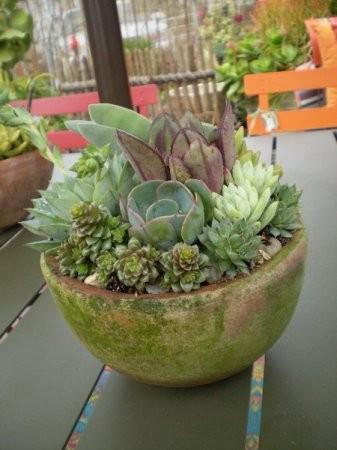
Propagation
Zebra Plants are propagated in the same way as Aloe plants. Propagate with a couple of inches of leaves, letting the wound heal for a couple of days before planting (let them dry out). They also produce pups (offsets) that can be removed from the mother plant and replanted. Either method you should water the soil once and then wait to see a small sign of new growth to prevent killing them with overwatering.

In their natural habitat (subtropical) Zebra Plants receive plenty of sun and periods without rainfall. Their succulent nature enables them to store water within the thick leaves when there’s no frequent rainfall.
The main difference between the two species (Haworthia fasciata and Haworthia attenuata) is the Haworthia fasciata has smoother inner leaves unlike the Haworthia attenuata that displays tubercles (warty growths). The Fasciata is supposedly more rarer than the Attenuata and seems to have fatter leaves.

Primarily they are grown in gardens. However, they are also grown in greenhouses, conservatories and within homes.
Flowering: If the Zebra Plant blooms appear (may not indoors) they are small tubular white or pink flowers growing from an inflorescence (thin kind of stem).
Foliage: The Zebra Plant forms a rosette of leaves. These leaves are very thick and patterned with Zebra like white stripes or tubercles that look like warts. They’re a clump forming plant in the wild so they can be grown with several or as many as you like in one container.

Growing Conditions
Temperature: 65°F – 80°F (8°C – 26°C) temperatures are very good and not much below 50°F (10°C).
Light: Display Zebra Plant anywhere it can receive plenty of sun or bright light. South facing windows will provide the most sun, however, east or west provide direct sun part of the day that I find more suitable.

Water: During the growing season from April to September water the Zebra Plant thoroughly and then water when the soil becomes dry to the touch (not bone dry though). Winter is a tricky time for these plants although they are a tough species. Many growers will overwater then alongside cold temperatures or drafts the plant can become very sick, or even die. The leaves are storage organs so during the winter water much less and allow the top soil to dry out.
Soil: Use a cactus potting mix that drains wells and provides plenty of air to the small roots. If making you own mix or buying another type, use part potting soil, part perlite and part sand.

Air Humidity: Normal room humidity will suffice.
Fertilizer: From April to September you can feed Zebra Plants with a diluted liquid fertilizer once every month. Do not feed during winter.
Repotting
Once the Zebra Plant outgrows the pot you can repot, during spring. Only move to a slightly bigger pot. Every two years I would renew the soil even if repotting is not required.

Propagation
Zebra Plants are propagated in the same way as Aloe plants. Propagate with a couple of inches of leaves, letting the wound heal for a couple of days before planting (let them dry out). They also produce pups (offsets) that can be removed from the mother plant and replanted. Either method you should water the soil once and then wait to see a small sign of new growth to prevent killing them with overwatering.
0
0
文章
Dummer. ゛☀
2017年08月28日

Zebra grass (Miscanthus sinensis ‘Zebrinus’) is native to Japan and one of the Miscanthus maiden grass cultivars, all of which are used as ornamental grasses. Zebra grass plants die back in winter but are perennial and re-sprout in spring. The grasses provide four seasons of interest with young spring variegated striped foliage, summer copper colored inflorescence, fall golden leaves and winter texture and form. Zebra ornamental grass can get up to 6 feet high and produces a spectacular screen or specimen plant.
Characteristics of Zebra Grass Plants
There are few showier plants for the garden. Zebra ornamental plants have long arching leaves with appealing stripes across the width, like dappled foliage in the sun. The plant is perennial but the foliage dies off in cold weather, leaving an architecturally interesting skeleton. It produces brand new deep green leaves in spring that begin to show more and more golden striping as the leaf matures. The plants are hardy to USDA plant hardiness zones 4 to 9. Choose a sunny to partially sunny location when growing zebra grass. Its clumping habit makes it perfect when planted in groups as a hedge or alone in a container.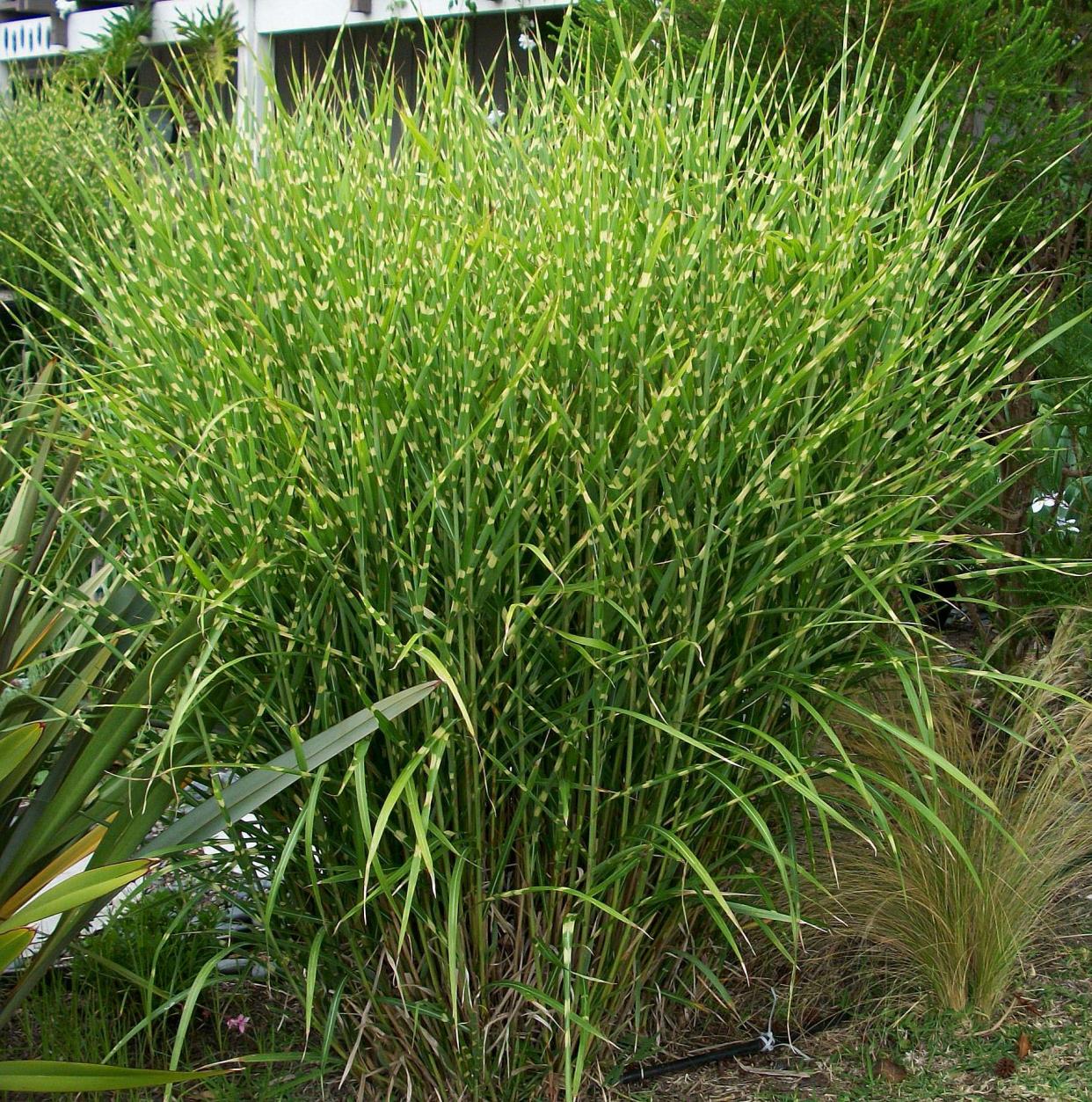
Site Conditions for Growing Zebra Grass
Hot sunny summers help the plant form copper colored, feathery inflorescences in September. The plant then produces fluffy seeds, which provide airy distraction to the late fall foliage. This grass produces best in moist soils or even boggy riparian edges but established grasses can tolerate short periods of drought. USDA zones 5 to 9 are ideal for zebra grass planting. Work in compost or leaf litter to a depth of at least 6 inches prior to installing the plant. Space the plants 36 to 48 inches apart and install in spring when the plant is mostly dormant. In the cooler zones, choose a place on the western side of the house in a sheltered area or where cold doesn’t pocket.
How to Care for Zebra Grass
Zebra grass plants are resistant to most pests and diseases. They may get some foliar rusts or small leaf damage from chewing insects, but for the most part the plant is quite strong and hardy. Provide a full sun environment and plenty of water for best growth. The plants work well in containers but will need more water than those in the garden bed. Fertilize in spring with a good organic plant food. Cut back the inflorescences in either fall or spring. If you like the look of the dry feathery flowers, leave them until spring. If not, cut them back to within a few inches of the crown of the plant in fall. Remove any damaged foliage as it occurs.
If the plant is in too much shade, the leaf blades can get floppy, but you can provide a stake or even a tomato cage to help prop them upright.

Characteristics of Zebra Grass Plants
There are few showier plants for the garden. Zebra ornamental plants have long arching leaves with appealing stripes across the width, like dappled foliage in the sun. The plant is perennial but the foliage dies off in cold weather, leaving an architecturally interesting skeleton. It produces brand new deep green leaves in spring that begin to show more and more golden striping as the leaf matures. The plants are hardy to USDA plant hardiness zones 4 to 9. Choose a sunny to partially sunny location when growing zebra grass. Its clumping habit makes it perfect when planted in groups as a hedge or alone in a container.

Site Conditions for Growing Zebra Grass
Hot sunny summers help the plant form copper colored, feathery inflorescences in September. The plant then produces fluffy seeds, which provide airy distraction to the late fall foliage. This grass produces best in moist soils or even boggy riparian edges but established grasses can tolerate short periods of drought. USDA zones 5 to 9 are ideal for zebra grass planting. Work in compost or leaf litter to a depth of at least 6 inches prior to installing the plant. Space the plants 36 to 48 inches apart and install in spring when the plant is mostly dormant. In the cooler zones, choose a place on the western side of the house in a sheltered area or where cold doesn’t pocket.

How to Care for Zebra Grass
Zebra grass plants are resistant to most pests and diseases. They may get some foliar rusts or small leaf damage from chewing insects, but for the most part the plant is quite strong and hardy. Provide a full sun environment and plenty of water for best growth. The plants work well in containers but will need more water than those in the garden bed. Fertilize in spring with a good organic plant food. Cut back the inflorescences in either fall or spring. If you like the look of the dry feathery flowers, leave them until spring. If not, cut them back to within a few inches of the crown of the plant in fall. Remove any damaged foliage as it occurs.

If the plant is in too much shade, the leaf blades can get floppy, but you can provide a stake or even a tomato cage to help prop them upright.
0
0



